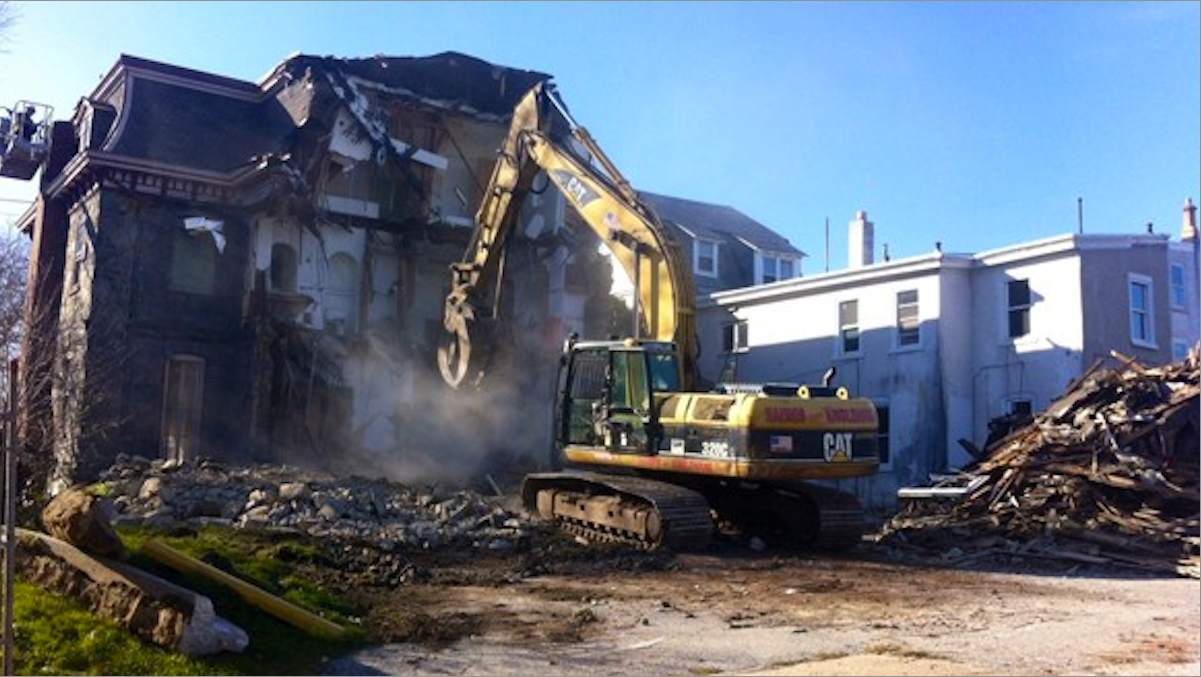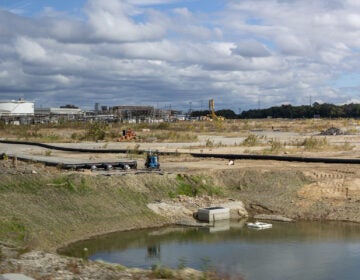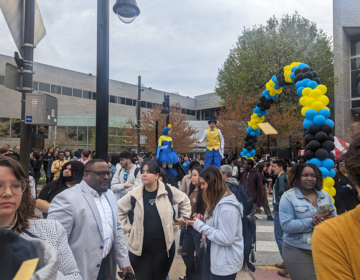Roxborough residents, planners mull zoning tool to protect neighborhood feel

December's demolition of the Bunting House spurred development tensions in Roxborough. (NewsWorks file art)
Continuing a quest to protect the character of their neighborhood, community leaders and city planners presented a brand-new plan to guide Roxborough’s future development.
Called a Neighborhood Conservation Overlay (NCO), it’s a zoning tool that can aid in the preservation of a neighborhood’s unique physical characteristics by regulating various design features of residential structures and mitigating the impact of new development.
While an NCO can apply to expansion or alteration, project leaders in Roxborough only expect to apply the guidelines to new construction in residential areas, not commercial corridors.
At present, the proposed NCO will exist in two contiguous rectangular areas centered along Ridge Avenue in central Roxborough, with one bordered by Roxborough Avenue and Hermitage St., and the other bounded by Gates St. and Leverington Ave.
“We don’t want to stop development, but we want to be considerate of the values and characteristics that this area already has,” said Kay Sykora, a Roxborough resident spearheading the NCO.
Meeting of the planning minds
Sykora and other residents met with Matt Wysong from the Philadelphia City Planning Commission last winter to lay out the various problems faced by her neighborhood, some of which was the result of the inevitable tensions between new development and less-dynamic residential areas.
This clash was to the forefront of media attention by the demolition of a historic Roxborough home in 2012.
Subsequently, they walked the neighborhood and talked about what could be, examining aspects of the available housing stock.
In other words, said Wysong, “addressing the new development that’s going on here, and what it should look like.”
On the table are various aspects of residential design and related city codes, from the presence of garage fronts to the dimension of driveways, along with the size of porches and windows and the materials used in retaining walls and fencing.
“All these things might individually pass off as inconsequential,” Wysong observed, “but when you put it all together, it’s what makes the character of your neighborhood.”
Look of the future
This is just one of several strategies being considered by community leaders in Roxborough to guide development in their neighborhood.
In July, residents participated in a presentation with the Planning Commission to consider possible zoning remapping for sections of their neighborhood. At that time, several sites in four sections of central Roxborough could receive changes to their zoning designation in order to guide future development.
Four primary zoning adjustments in consideration, which will create designations either more dense or less dense, and better match properties to current or future uses.
Wysong said Thursday that the project is moving along as expected, with a bill set to be drafted later this month. It will be submitted to the office of Fourth District Councilman Curtis Jones, Jr., who will then introduce it into City Council in October, with final approval from Council envisioned by Thanksgiving.
A National Registered Historic District is also being considered, but NCO leaders recognize that this would be largely symbolic, with various incentives attached but little apparatus for enforcement.
Support and questions
At the meeting, residents signaled interest in the proposal, but wanted to learn how the plan could affect their properties and neighborhoods directly.
A key point that project leaders emphasized was that the NCO was primarily geared to new construction. Guidelines about major renovations are also being considered, but are not currently on the table.
Primarily, Sykora said, the goal of the NCO is to encourage builders to “keep the character” of the surrounding neighborhood.
Asked about the paving of front yards to turn into ad-hoc parking spaces, Wysong said that it is a topic being wrestled with by the project’s leaders.
While it’s perfectly legal for property owners to pave their front yards, it’s a practice he’d like to discourage. However, he said this topic is unlikely to be incorporated into the NCO because of larger citywide policies.
Responding to a resident’s observation about the plethora of what she considered unenforced building regulations already on the books, Sykora responded that neighbors often serve as the first line of defense.
“The attention Licenses and Inspections and the city pay depends on the activity level of the community,” she observed.
Providing an alternate point of view, developer Vaughan Buckley maintained that respectable builders adhere to regulations, but that their intentions are sometimes undermined by so-called “wildcard” builders, who cut corners and skew the housing market.
“If we can have an overlay that makes sense [and] is financially feasible both for the developers and the buyers that want to live in this market, I’m all for it,” he said. “The involvement of the community to make sure that standards are upheld will make it more attractive for us to do it properly.”
Where to go from here?
After Thursday’s meeting, project leaders said they will regroup and further refine the NCO’s guidelines.
The Central Roxborough Civic Association will then request that the Planning Commission initiate the formal creation of the NCO.
After this step, an additional public meeting presenting the finalized plan will be held in the coming months.
Wysong said that no formal vote will take place at the meeting. Instead, residents will have to file a “disapproval” with the Clerk of City Council either individually or via petition.
Fifty-one percent of residents would need to file a disapproval in order for the project to be halted. However, should residents embrace the NCO, Wysong envisioned a presentation to City Council next spring.
Regardless of their acceptance of the NCO, the project’s leaders want community members to be stakeholders.
“Even if they’re against it, we want this to be something that everyone is involved in,” Wysong said. “We don’t want this to go into effect and find out half the neighborhood was against because they didn’t know about it. That just creates problems. We’d rather that the project was community driven.”
WHYY is your source for fact-based, in-depth journalism and information. As a nonprofit organization, we rely on financial support from readers like you. Please give today.




